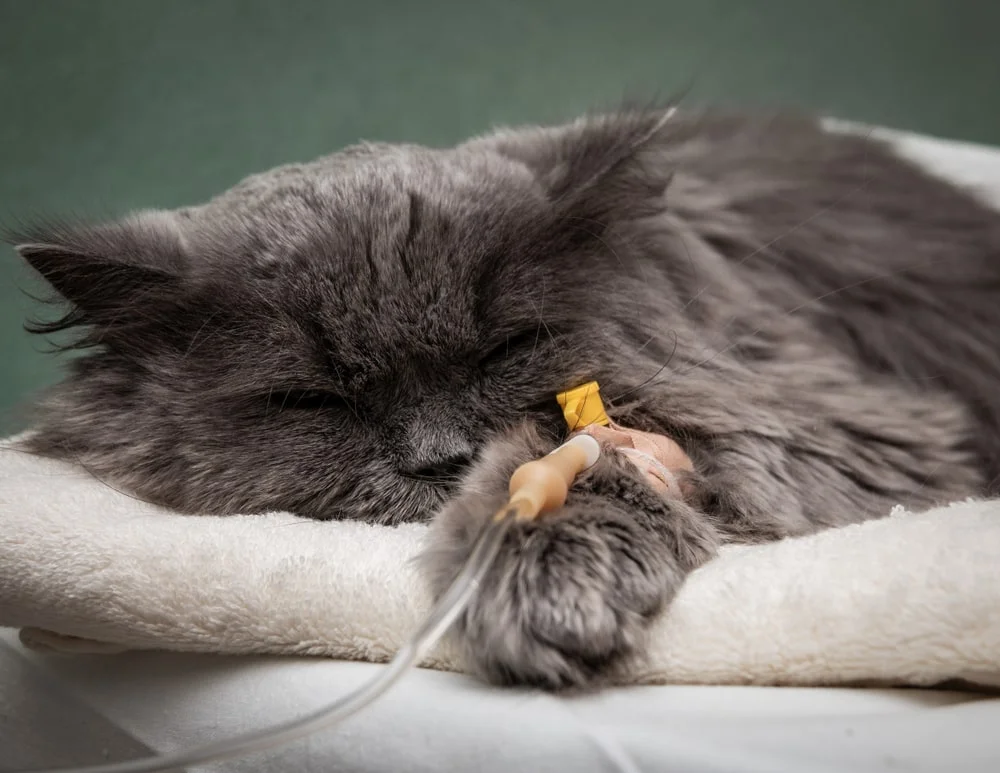PET HEALTH
Cancer in Cats: Types, Treatments, & Cost
The last thing we want is for our cat to suffer from cancer. But, according to the National Cancer Institute, nearly 6 million cats are diagnosed with cancer each year.1 The good news is cancer in cats is often treatable, especially when you catch it early.Read on to learn about common cancers in cats, how to spot the symptoms, what the treatment options are, what they may cost, and how pet insurance can help make care more cost effective for your kitty.
Pet Insurance May Help Cover Cancer Costs
Signs of Cancer in Cats
Because cats can get different types of cancer, there are a range of symptoms to look out for.
Here are some of the most common signs of cancer in cats:2
Unusual lumps or growths on or beneath your cat’s skin
- Unusual lumps or growths on or beneath your cat’s skin
- Vomiting
- Diarrhea
- Changes in appetite
- Severe weight loss
- Strong odor in your cat’s mouth
- Swollen lymph nodes
- Coughing
- Abnormal bleeding
- Lameness
If your cat is showing these signs, it’s a good idea to take them to the vet.
Can you catch feline cancer early?
Cats tend to be good at hiding illness and pain.3 But by paying close attention to your cat’s behavior and physical traits, you can give yourself a better chance of spotting when something may be wrong.
Once in a while, as you pet your cat, try to look and feel for any new lumps on their body. You can also monitor your cat’s weight for sudden changes.2
Another way you can try to catch cancer early is to check your cat’s mouth from time to time. Strange growths, unusual colors, or unpleasant smells could all be signs of cancer.2
Is cancer in cats preventable?
Cancer may not be totally preventable.2 But you can try to reduce your cat’s risk with positive health and lifestyle choices.
Feeding your cat a healthy diet, reducing stress, making sure they get enough exercise, not letting them stay in the sun too long, avoiding secondhand smoke, and getting regular vet visits are all ways you can help keep your cat happy and healthy.
Types of Cat Cancer
Here are some of the most common feline cancers:
Lymphoma
Lymphoma is related to the feline leukemia virus (FeLV). It involves immune system cells that travel throughout a cat’s body in blood and lymphatic vessels. Lymphoma commonly affects the intestines, so symptoms can be similar to intestinal diseases. It can also affect the chest and kidneys.4
You don’t typically see tumors with lymphoma, so diagnosing this cancer requires examining cells under a microscope. Lymphoma is usually treated with chemotherapy but is considered incurable, with cats going into remission for 2 months to 3 years at a time, depending on the severity.4
Squamous cell carcinoma
Squamous cell carcinoma (SCC) is a type of skin cancer that typically affects a cat’s nose, ears, nail beds, or corners of the eyes. Usually, a single lesion is found in the affected area. However, multicentric SCC is also possible and may result in multiple lesions in different places. Tumors may show up as ulcers, a raised red area, or cauliflower-like growth.5
Even with multicentric SCC, this cancer typically doesn’t spread, but it can happen. Treatment for SCC usually entails surgical removal of skin tumors. However, if a cat’s nose is affected, radiation therapy may be involved.5
Mammary carcinoma
Mammary tumors affect a cat’s mammary glands and are caused by abnormal replication of the cat’s breast tissue. They’re usually seen in middle-aged to senior cats. Often, the formation of these tumors is related to a cat’s hormones, with female cats that haven’t been spayed seven times more likely to develop mammary tumors. Usually, you’ll be able to see or feel a lump under the skin near a nipple.6
Treatment for mammary carcinoma often requires surgery to remove the breast tissue, followed by chemotherapy to prevent the cancer from spreading. Larger tumors, multiple tumors, and cancer that’s spread to blood vessels can be harder to treat — so early detection and action is important.6
Basal cell tumor
Basal cell tumors are abnormal growths caused by uncontrolled replication of basal cells in hair follicles, sweat glands, or sebaceous (oil) glands. Basal cells make up the outermost skin layer. Basal cell tumors may show as firm, hairless, raised bumps on the skin — usually around the neck, head, and shoulders. Although most often these tumors are benign and don’t spread, they can sometimes be cancerous.7
Treatment typically involves surgically removing the mass, and the prognosis tends to be good after removal.7
Mast cell tumor
Mast cell tumors are made up of mast cells found on the skin or internal organs, typically the spleen and intestines. Mast cells are a type of white blood cell in the outermost skin layer. Mast cell tumors usually show up as hard, flattened areas or small lumps in the skin around the head and neck. But if the spleen or intestines are affected, you likely won’t see a bump. Instead, there may be signs similar to intestinal diseases.8
This type of cancer may spread if the spleen and intestines are affected. Treatment usually involves surgical removal of the tumors and potentially chemotherapy or radiation therapy.8
Osteosarcoma
Osteosarcoma is a form of bone cancer caused by abnormal production of bone cells that commonly affects the leg bones. However, osteosarcoma can also affect tissues, like those of the spleen, kidneys, mammary glands, and liver. Unfortunately, this cancer can be very painful for cats. Swelling, pain or warmth to the touch, lethargy, and lameness in an affected limb may be signs of osteosarcoma.9
Since osteosarcoma mainly affects the legs, amputation of the affected limb is a common treatment. As it’s rare for this cancer to spread, amputation is often effective, with chemotherapy usually unnecessary.9
Cat Cancer Diagnosis
If you notice your cat exhibiting one or more of the symptoms listed above, be sure to contact your vet to share your concerns and schedule a full exam.
First, the veterinarian will likely review your pet’s medical history. This can help them understand what they might find during the examination, since there could be other possible explanations for symptoms that your cat’s medical history might explain.
Next, your vet will usually perform a physical exam. They’ll check your cat for lumps and bumps that might be signs of a tumor and other telltale signs.
Other methods your vet may use to diagnose cat cancer include:10
- Urine5 and blood tests
- X-rays
- Ultrasound imaging
- Endoscopies (internal cameras)4
- CT scans
- MRIs
- Fine needle aspirate (FNA) sampling to collect cells to check for cancer2
- Biopsies2
Vets won’t usually have to complete all of these tests to give a diagnosis. Once your vet has their diagnosis ready, it’s time to discuss next steps.
Cancer Treatment for Cats
Fortunately, cancer in cats is often treatable due to advances in medical, surgical, and radiographic treatment.11 Although it isn’t always possible to cure cancer, cats may still live long lives despite their diagnosis.
Treatment options will vary depending on the type of cancer. The most common treatments for cat cancer are surgical removal of tumors, radiation, and chemotherapy. Cats tend to tolerate chemotherapy better than humans, typically without losing fur or appearing sick.4 Your veterinarian can guide you through the best treatment option(s) for your cat.
Don’t be afraid to seek a second opinion from another vet or a veterinary oncologist. This may help when it comes to diagnosis, treatment, and cost.
Cat cancer treatment costs
Cancer costs can include initial examinations, diagnosis, staging (searching for cancer elsewhere in the body), and treatment. These costs can also depend on the size and location of the tumor, your cat’s size, the diagnostics necessary — like X-rays, ultrasounds, bloodwork, and biopsies — the type of treatment chosen, and how well your cat responds to their treatment plan.12
For treatment, surgery may cost at least a few hundred dollars, chemotherapy may cost a few hundred to several thousand dollars, and radiation therapy may cost upwards of $7,000.12 Costs may be higher if you see a specialist compared to your cat being treated at your general vet’s office. Planning ahead by getting pet insurance before a diagnosis can help make these costs more manageable.
What To Do if Your Cat Has Cancer
Caring for your cat if they have cancer can be tough, both financially and emotionally. You want to do everything you can to ensure they have the best quality of life moving forward. This may be challenging to do if your vet bills are not cost-effective. But there’s hope.
You may be able to negotiate a payment plan with your cat’s vet or specialist(s). Across the country, certain clinics are dedicated to providing free or low-cost services. There are also organizations that offer financial assistance for pet cancer treatments. Or you may be able to take your pet to an accredited veterinarian college for discounted services.
Ways to support your cat’s treatment
Outside of medical treatment, you can do things at home to help support your cat’s strength, whether they’re recovering or terminal:11
- Pain management: Depending on what your vet recommends, you may be able to administer pain medication at home. Know the ins and outs of their medication to help provide as much pain relief as possible.
- Diet: Depending on the type of cancer your cat has, it may be harder for them to eat or keep a healthy weight. Make sure your cat is eating and staying hydrated according to your vet’s recommendations.
- Hygiene: If your cat is too sick to groom themselves, you’ll need to step in. You can use a damp washcloth to wipe down their fur and brush them regularly.
- Environment: Create a calm and comfortable environment for your cat. If they’re unable to move easily, bring their litter box closer to them and make sure any play time or snuggling isn’t causing discomfort.
While many cats do beat cancer, sadly, some don’t. If you find yourself in this difficult position, choosing euthanasia could help you end your cat’s suffering peacefully.11 Cremation is then an option many pet parents choose as they put their cat to rest. Since these options aren’t usually free, a policy from MetLife Pet may help with the costs so you can focus on what you and your family need at this difficult time.
And if you’re looking for professional support, our cat insurance policies may help cover the cost of grief counseling.13
Consider Investing in Pet Insurance
Cancer can be expensive. But you don’t have to let these costs stop you from giving your cat the care they need. By purchasing cat insurance while your feline is still healthy, you could help make the best care more cost-effective when they need it.
Prepare for the future with your cat by getting a free, personalized quote today.


